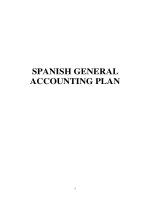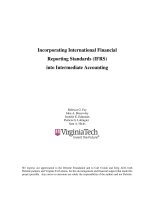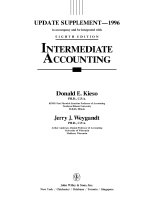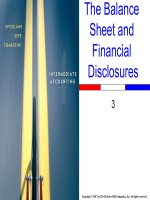Intermediate Accounting - Chap004 pptx
Bạn đang xem bản rút gọn của tài liệu. Xem và tải ngay bản đầy đủ của tài liệu tại đây (932.81 KB, 57 trang )
Copyright © 2007 by The McGraw-Hill Companies, Inc. All rights reserved.
The Income
Statement and
Statement of
Cash Flows
4
4-2
Learning Objectives
Explain the difference between net income and
comprehensive income and how we report
components of the difference.
4-3
Comprehensive Income
An expanded
version of income
that includes four
types of gains and
losses that
traditionally have
not been included
in income
statements.
4-4
Other Comprehensive Income
Statement of Financial Accounting Standards No. 130
Comprehensive income includes traditional net income
and changes in equity from nonowner transactions.
Statement of Financial Accounting Standards No. 130
Comprehensive income includes traditional net income
and changes in equity from nonowner transactions.
1. Changes in the market value of securities available for sale
(described in Chapter 12).
2. Reporting a pension liability sometimes requires a reduction in
shareholders’ equity (described in Chapter 17).
3. When a derivative is designated as a cash flow hedge is adjusted to
fair value, the gain or loss is deferred as a component of
comprehensive income and included in earnings later, at the same
time as earnings are affected by the hedged transaction (described in
Chapter 14).
4. Gains or losses from changes in foreign currency exchange rates
(discussed elsewhere in your accounting curriculum).
1. Changes in the market value of securities available for sale
(described in Chapter 12).
2. Reporting a pension liability sometimes requires a reduction in
shareholders’ equity (described in Chapter 17).
3. When a derivative is designated as a cash flow hedge is adjusted to
fair value, the gain or loss is deferred as a component of
comprehensive income and included in earnings later, at the same
time as earnings are affected by the hedged transaction (described in
Chapter 14).
4. Gains or losses from changes in foreign currency exchange rates
(discussed elsewhere in your accounting curriculum).
4-5
Accumulated Other Comprehensive Income
In addition to reporting comprehensive income that
occurs in the current period, we must also report these
amounts on a cumulative basis in the balance sheet as
an additional component of shareholders’ equity.
In addition to reporting comprehensive income that
occurs in the current period, we must also report these
amounts on a cumulative basis in the balance sheet as
an additional component of shareholders’ equity.
(In millions, except shares) 2004 2003
Common Stockholders' Investment:
Common stock, $.10 par value, 800 million
shares authorized, 300 million shares
issued for 2004 and 299 million shares 30$ 30$
issued for 2003
Additional paid-in capital 1,079 1,088
Retained earnings 7,001 6,250
Accumulated other comprehensive loss (46) (30)
8,064 7,338
Less deferred compensation and treasury
stock at cost 28 50
Total common stockholders' investment 8,036$ 7,288$
FedEx Corporation
Balance Sheet
31-May
4-6
Learning Objectives
Discuss the importance of income from
continuing operations and describe its
components.
4-7
Expenses
Outflows of
resources
incurred in
generating
revenues.
Revenues
Inflows of
resources
resulting
from
providing
goods or
services to
customers.
Gains and
Losses
Increases or
decreases in
equity from
peripheral or
incidental
transactions
of an entity.
Income from Continuing Operations
Income from Continuing Operations
Income Tax
Expense
Because of
its
importance
and size,
income tax
expense is a
separate
item.
4-8
Operating
Income
Nonoperating
Income
Operating Income Versus Nonoperating
Income
Includes revenues
and expenses
directly related to
the principal
revenue-
generating
activities of the
company
Includes gains and
losses and
revenues and
expenses related
to peripheral or
incidental
activities of the
company
4-9
Income Statement (Single-Step)
Expenses
& Losses
{
{
Revenues
& Gains
{
Proper Heading
4-10
Income Statement (Multiple-Step)
{
Non-
operating
Items
{
Gross
Profit
{
Proper Heading
Operating
Expenses
{
4-11
Learning Objectives
Describe earnings quality and how it is
impacted by management practices to
manipulate earnings.
4-12
Earnings Quality
Earnings quality refers to
the ability of reported
earnings to predict a
company’s future.
The relevance of any
historical-based financial
statement hinges on its
predictive value.
4-13
Manipulating Income and Income Smoothing
“Most managers prefer to report earnings that follow a
smooth, regular, upward path.”
1
Two ways to manipulate income:
1. Income shifting
2. Income statement
classification
1
Bethany McLean, “Hocus-Pocus: How IBM Grew 27% a Year,” Fortune, June 26, 2000, p. 168.
4-14
Learning Objectives
Discuss the components of operating and
nonoperating income and their relationship to
earnings quality.
4-15
Operating Income and Earnings Quality
Should all items of revenue and expense included in
operating income be considered indicative of a
company’s permanent earnings?
No, not necessarily.
Operating expenses may include the following unusual items
that may or may not continue in the future:
•
Restructuring costs
•
Goodwill impairment
•
Long-lived asset impairment
•
In-process research and development
4-16
Operating Income and Earnings Quality
Restructuring Costs
Costs associated with shutdown or
relocation of facilities or
downsizing of operations are
recognized in the period incurred.
Goodwill Impairment
and Long-lived Asset
Impairment
Involves asset impairment losses
or charges (discussed further in
Chapters 10 & 11).
In-process Research
and Development
Results from certain business
combinations (discussed further in
Chapter 10).
4-17
Nonoperating Income and Earnings Quality
Gains and losses from the sale of operational
assets and investments often can significantly
inflate or deflate current earnings.
Example
As the stock market boom reached its
height late in the year 2000, many
companies recorded large gains from
sale of investments that had
appreciated significantly in value.
How should
those gains be
interpreted in
terms of their
relationship to
future
earnings? Are
they transitory
or permanent?
4-18
Pro Forma Earnings
Companies often voluntarily provide a pro forma
earnings number when they announce annual or
quarterly earnings. Pro forma earnings are
management’s assessment of permanent earnings.
The Sarbanes-Oxley Act
Section 401 requires a
reconciliation between pro
forma earnings and
earnings determined
according to GAAP.
4-19
Separately Reported Items
Reported separately, net of taxes:
Discontinued
operations
$ xxx
xx
xxx
xx
xx
Net Income $ xxx
Extraordinary items (net of $xx in
taxes)
Income from continuing operations
before income taxes and
extraordinary items
Income tax expense
Income from continuing operations
before extraordinary items
Discontinued operations (net of $xx
in taxes)
Extraordinary
items
A third item, the
cumulative effect of
a change in
accounting
principle, was
eliminated from
separate reporting
by a new
accounting
standard in 2005.
4-20
Intraperiod Income Tax Allocation
Income Tax Expense must be associated with
each component of income that causes it.
Income Tax Expense must be associated with
each component of income that causes it.
Show Income Tax
Expense related to
Income from
Continuing
Operations.
Show Income Tax
Expense related to
Income from
Continuing
Operations.
Report effects of
Discontinued Operations
and Extraordinary Items
NET OF RELATED
INCOME TAXES.
Report effects of
Discontinued Operations
and Extraordinary Items
NET OF RELATED
INCOME TAXES.
4-21
Learning Objectives
Define what constitutes discontinued
operations and describe the appropriate
income statement presentation for these
transactions.
4-22
A discontinued operation is the sale or
disposal of a component of an entity.
A component comprises operations and
cash flows that can be clearly
distinguished, operationally and for
financial reporting purposes, from the rest
of the entity.
A component could include:
Reportable segments
Operating segments
Reporting units
Subsidiaries
Asset groups
Discontinued Operations
4-23
Discontinued Operations
Report results of operations separately if two
conditions are met:
The operations and
cash flows of the
component have been
(or will be) eliminated
from the ongoing
operations.
The entity will not have
any significant
continuing involvement
in the operations of the
component after the
disposal transaction.
4-24
Discontinued Operations
Reporting for Components Sold
Operating income or
loss of the component
from the beginning of
the reporting period to
the disposal date.
Gain or loss on the
disposal of the
component.
Reporting for Components Held For Sale
Operating income or
loss of the component
from the beginning of
the reporting period to
the end of the reporting
period.
An “impairment loss” if
the carrying value of
the assets of the
component is more
than the fair value
minus cost to sell.
4-25
During the year, Apex Co. sold an
unprofitable component of the company. The
component had a net loss from operations
during the period of $150,000 and its assets
sold at a loss of $100,000. Apex reported
income from continuing operations of
$128,387. All items are taxed at 30%.
How will this appear in the income
statement?
Discontinued Operations Example









